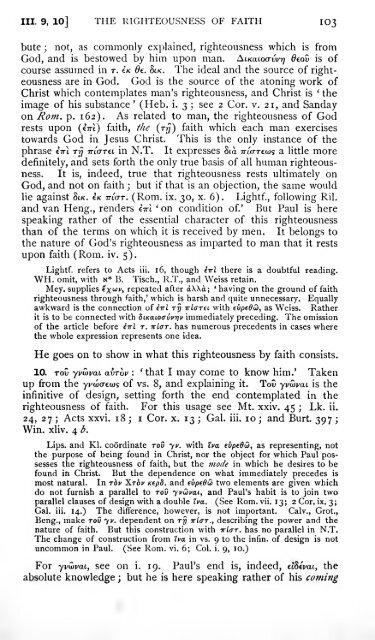Philippians and Philemon - MR Vincent - 1906.pdf
Philippians and Philemon - MR Vincent - 1906.pdf
Philippians and Philemon - MR Vincent - 1906.pdf
You also want an ePaper? Increase the reach of your titles
YUMPU automatically turns print PDFs into web optimized ePapers that Google loves.
III. 9, 10] THE RIGHTEOUSNESS OF FAITH IO3<br />
bute ; not, as commonly explained, righteousness which is from<br />
God, <strong>and</strong> is bestowed by him upon man. ;Ocov is of<br />
course assumed in r. . Slk. The ideal <strong>and</strong> the source of righteousness<br />
are in God. God is the source of the atoning work of<br />
Christ which contemplates man's righteousness, <strong>and</strong> Christ is ' the<br />
image of his substance ' (Heb. i. 3 ; see 2 Cor. v. 21, <strong>and</strong> S<strong>and</strong>ay<br />
on J^om. p. 162). As related to man, the righteousness of God<br />
rests upon {em) faith, t/ie {rrj) faith which each man exercises<br />
towards God in Jesus Christ. This is the only instance of the<br />
phrase eVi rrj in N.T. It expresses ^la.?alittle more<br />
definitely, <strong>and</strong> sets forth the only true basis of all human righteousness.<br />
It is, indeed, true that righteousness rests ultimately on<br />
God, <strong>and</strong> not on faith ; but if that is an objection, the same would<br />
lie against . . (Rom. ix. 30, . 6). Lightf., following Ril.<br />
<strong>and</strong> van Heng., renders - ' on condition of.' But Paul is here<br />
speaking rather of the essential character of this righteousness<br />
than of the terms on which it is received by men. It belongs to<br />
the nature of God's righteousness as imparted to man that it rests<br />
upon faith (Rom. iv. 5).<br />
Lightf. refers to Acts iii. 16, though iwl there is a doubtful reading.<br />
WH. omit, with N* B. Tisch., R.T., <strong>and</strong> Weiss retain.<br />
Mey. supplies €xwc, repeated after; ' having on the ground of faith<br />
righteousness through faith,' which is harsh <strong>and</strong> quite unnecessary. Equally<br />
awkward is the connection of with,as Weiss. Rather<br />
it is to be connected with immediately preceding. The omission<br />
of the article before iirl .. has numerous precedents in cases where<br />
the whole expression represents one idea.<br />
He goes on to show in what this righteousness by faith consists.<br />
10. :<br />
' that I may come to know him.' Taken<br />
up from the of VS. 8, <strong>and</strong> explaining it. is the<br />
infinitive of design, setting forth the end contemplated in the<br />
righteousness of faith. For this usage see Mt. xxiv. 45<br />
; Lk. ii.<br />
24, 27 ; Acts xxvi. 18 ; i Cor. x. 13 ; Gal. iii. 10 ; <strong>and</strong> Burt. 397 ;<br />
Win. xliv. 4 .<br />
Lips, <strong>and</strong> Kl. coordinate yv. with ,as representing, not<br />
the purpose of being found in Christ, nor the object for which Paul possesses<br />
the righteousness of faith, but the mode in which he desires to be<br />
found in Christ. But the dependence on what immediately precedes is<br />
most natural. In ^ . <strong>and</strong> two elements are given which<br />
do not furnish a parallel to yvdvai, <strong>and</strong> Paul's habit is to join two<br />
parallel clauses of design with a double tva. (See Rom. vii. 13:2 Cor. ix. 3;<br />
Gal. iii. 14.) The difference, however, is not important. Calv., Grot.,<br />
Beng., make yv. dependent on ., describing the power <strong>and</strong> the<br />
nature of faith. But this construction with . has no parallel in N.T.<br />
The change of construction from in vs. 9 to the infin. of design is not<br />
uncommon in Paul. (See Rom. vi. 6; Col. i. 9, 10.)<br />
For /, see on i. 19. Paul's end is, indeed, ciSeVat, the<br />
absolute knowledge ; but he is here speaking rather of his cotning





